Isothermal Nucleic Acid Amplification Technology (INAAT) Market Size
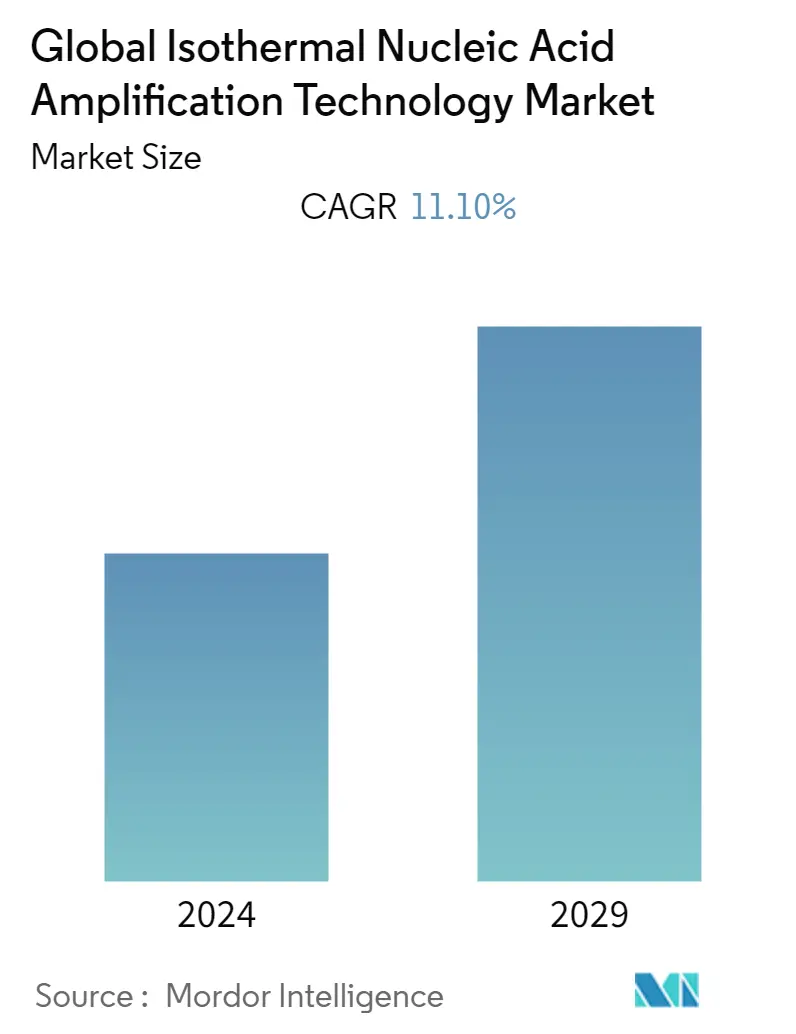
| Study Period | 2019 - 2029 |
| Base Year For Estimation | 2023 |
| CAGR | 11.10 % |
| Fastest Growing Market | Asia Pacific |
| Largest Market | North America |
| Market Concentration | Medium |
Major Players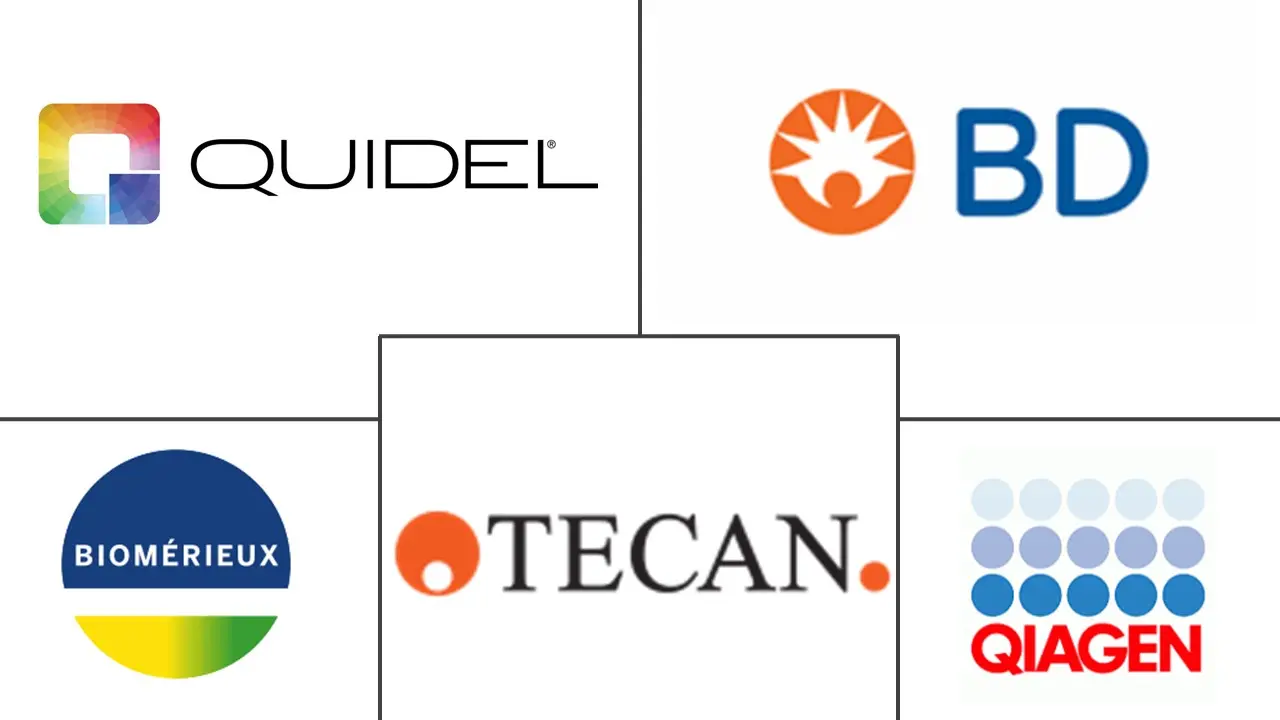
*Disclaimer: Major Players sorted in no particular order |
Isothermal Nucleic Acid Amplification Technology (INAAT) Market Analysis
The Isothermal Nucleic Acid Amplification Technology (INAAT) Market is expected to register a CAGR of 11.1% during the forecast period 2022-2027.
COVID-19 is expected to have a significant impact on the growth of the market. The COVID-19 pandemic observed isothermal methods implemented as a basic technology used for the diagnosis of SARS-CoV-2 RNA in home and clinical testing centers. Furthermore, in March 2020, Abbott received the United States Food and Drug Administration approval for the Emergency use of ID NOW COVID-19, an instrument-based, isothermal, rapid system for the qualitative finding of disease. Thus increased utilization during pandemic and product approvals and launches are expected to accelearte the growth of the market during the forecast period.
The increasing incidences of chronic diseases and an aging population, an increase in the adoption of INAAT over PCR, and a rise in demand for low-cost and effective diagnostics procedures are some of the major factors that are driving the growth of the market studied. According to the World Health Organization report in February 2022, Cancer was one of the major cause of death worldwide. The report states that Each year, approximately 400,000 children develop cancer in which cervical cancer is the most common in 23 countries. The report Published by International Agency for Research on Cancer (IARC) in December 2020 that the global cancer burden has risen to 19.3 million cases. and thus, due to the high prevalence of cancer around the world, the demand for effective therapy or treatment is increasing which is expected to drive the growth of the market.
Nucleic acid amplification has several applications in the healthcare industry starting from research to clinics. Until now, PCR has been the most widely-used amplification technology across the world. A thermal cycler is required in PCR, as various temperatures need to be maintained at different steps of the amplification process. Additionally, contaminants must be removed for effective amplification through this technology. The thermal cycler itself is costly, and sample preparation to remove contaminants from the sample makes the overall process more costly and time-consuming.
Owing to this high cost, the technique has witnessed limited adoption in developing countries, where the demand for this technology is extremely high, especially for clinical application. This high demand has led to the development of novel innovative techniques, such as isothermal nucleic acid amplification technology.
The isothermal technique, as the name suggests, is performed at a fixed temperature. This temperature can vary depending on the type of nucleic acid. The tedious task of preparing a sample is not required, as the technology can take a sample directly for amplification. Additionally, the technology is affordable, making it accessible for people belonging to different economic levels across the world. The low-cost associated with technology is likely to result in increased adoption, especially in the developing regions.
Hence, owing to the cost benefits and the use of novel technologies, INAAT market is expected to grow in the coming future.
Isothermal Nucleic Acid Amplification Technology (INAAT) Market Trends
This section covers the major market trends shaping the Isothermal Nucleic Acid Amplification Technology Market according to our research experts:
Loop-mediated Isothermal Amplification (LAMP) Segment is Expected to Hold a Major Market Share in the Isothermal Nucleic Acid Amplification Technology (INAAT) Market
Loop-mediated isothermal amplification (LAMP) test is the most widely used technique, and its usage is expected to grow rapidly during the forecast period. In this technique, a minimum of four sets of primers are used, two outer primers and two inner primers. There are various software that are available for primer designing, such as primer explorer, LAMP designer, and other software. These loop primers bind to the nucleic acid template and further accelerate the reaction. The technique can be used for the amplification of both, DNA and RNA.
Since its inception in the early 2000s, LAMP tests have been developed for a variety of disease-causing agents, due to their capability of amplifying both DNA and RNA. Additionally, the tests can be used for the identification of genetically modified organisms.
This technique has two major competitive advantages over PCR technology. First, the LAMP test is tolerant of PCR inhibitors, which makes it well-suited for direct analysis of the sample. Secondly, there is no need of a thermocycler, as it is performed at a fixed temperature. These two advantages make it useful in point-of-care diagnostics. As the market for point-of-care diagnostics is growing, the LAMP segment of the market studied is also likely to grow proportionally.
According to World Ageing 2020 report, people aged 65 years or over in the world is projected to reach to 1.5 billion in 2050. In addition, by 2050, 1 in 6 people in the world will be above 65 years of age,. Thus, owing to above all factors segment is expected to show growth over forecast period.
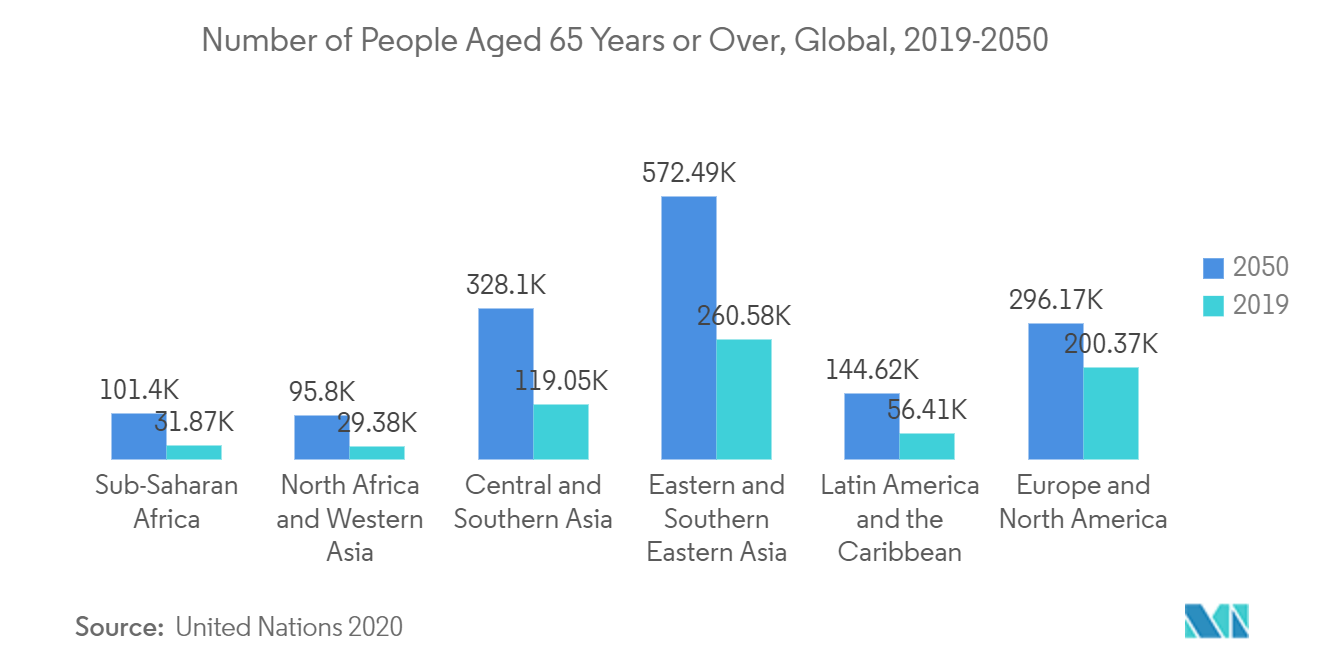
North America is Expected to Hold a Significant Share in the Market and Expected to do Same in the Forecast Period
North America dominates the Isothermal Nucleic Acid Amplification Technology (INAAT) market, owing to a high incidence of chronic diseases, technological advancement in isothermal nucleic acid amplification technology (INAAT), and increasing adoption of INAAT over conventional techniques in the region.
According to the Centers for Disease Control and Prevention (CDC), in 2020, the total number of Americans with chronic diseases was projected to be approximately 157 million, with 81 million having multiple conditions. Similarly, according to GLOBOCAN 2020, 2,281,658 new cancer cases were diagnosed in the United States in 2020, with 612,390 fatalities.
Also, the Per Capita expenditure on healthcare in North America is also expected to contribute to the growth of the marketr in this region . According to the data published by the United States Department of Commerce in 2021 health spending in Canada is anticipated to reach USD 308 billion. It is estimated that health spending will signify 12.7% of Canada's GDP.
Thus the above mentioned factors are expected to drive the growth of the market in this region during the forecast period.
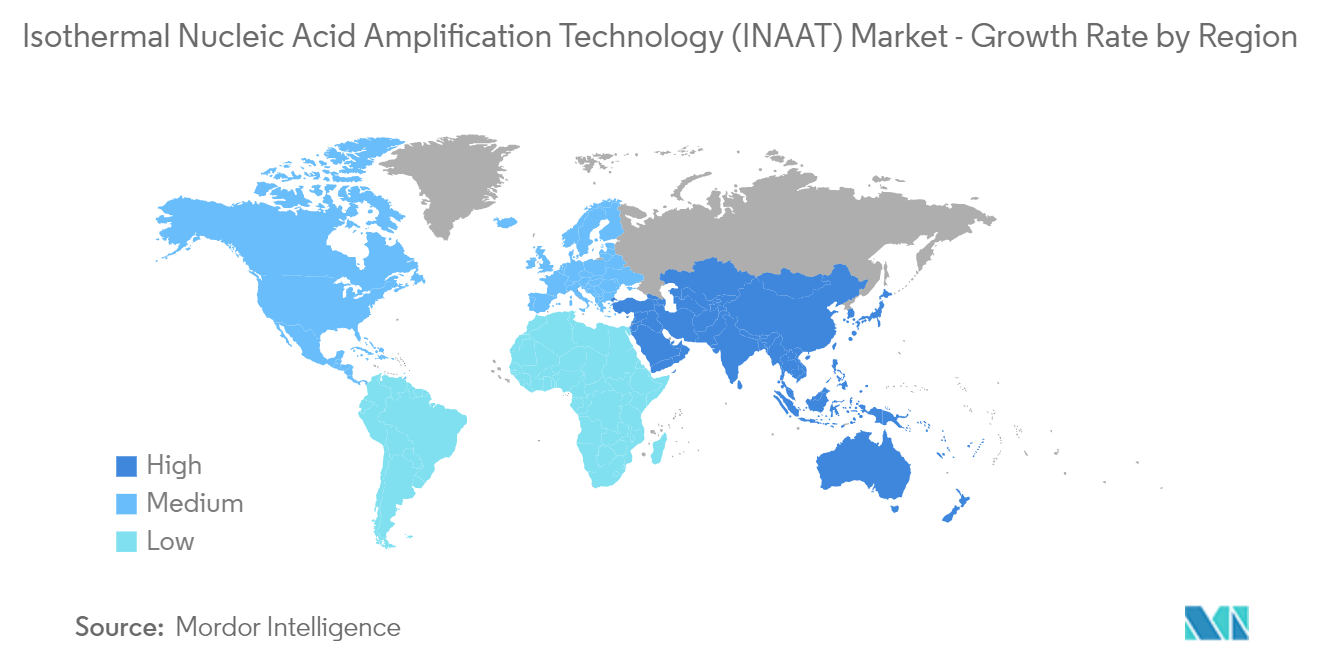
Isothermal Nucleic Acid Amplification Technology (INAAT) Industry Overview
The Isothermal Nucleic Acid Amplification Technology (INAAT) Market is consolidated in nature and consists of global players such as Becton Dickinson and Company, Qiagen NV, bioMerieux, etc. With the rising use of INAA Technology across developing countries, it is expected that few local players in countries like China, India, etc. will penetrate the market in the near future.
Isothermal Nucleic Acid Amplification Technology (INAAT) Market Leaders
-
Becton Dickinson and Company
-
Qiagen NV
-
BioMerieux SA
-
Quidel Corporation
-
Tecan Genomics, Inc.
*Disclaimer: Major Players sorted in no particular order
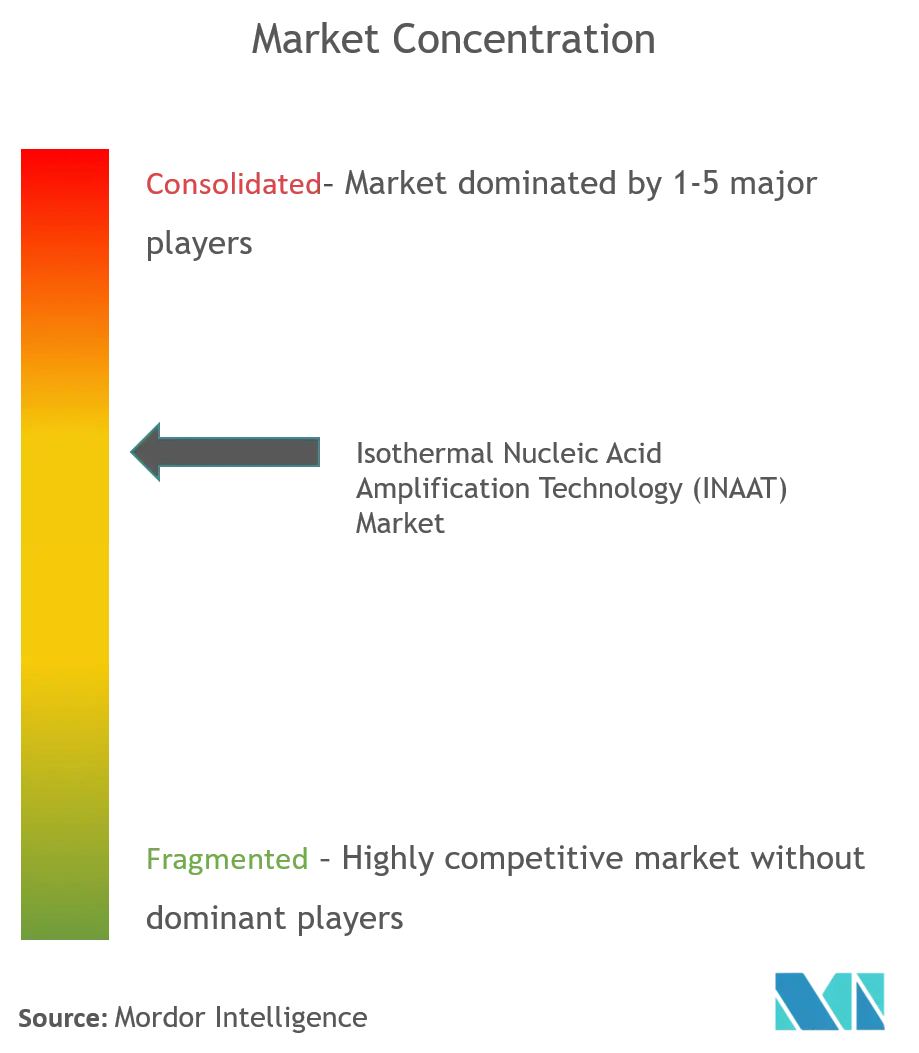
Isothermal Nucleic Acid Amplification Technology (INAAT) Market News
- In August 2022, LGC Clinical Diagnostics announced the extension of their exclusive collaboration with Stanford Medicine's Department of Obstetrics and Gynecology and Metabolic Health Center supporting global genetic and metabolic diagnostic testing.
- In May 2022 Meridian Bioscience launched two new innovative isothermal amplification products, Lyo-Ready Direct DNA LAMP Saliva Mix and Lyo-Ready Direct RNA/DNA LAMP saliva mix. These are used for direct detection of DNA and RNA in point of care dagnostics assays.
Isothermal Nucleic Acid Amplification Technology (INAAT) Market Report - Table of Contents
1. INTRODUCTION
- 1.1 Study Deliverables
- 1.2 Study Assumptions
- 1.3 Scope of the Study
2. RESEARCH METHODOLOGY
3. EXECUTIVE SUMMARY
4. MARKET DYNAMICS
- 4.1 Market Overview
-
4.2 Market Drivers
- 4.2.1 Increasing Incidences of Chronic Diseases And Aging Population
- 4.2.2 Increase in the Adoption of INAAT Over PCR
- 4.2.3 Rise In The Miniaturization of Nucleic Acid-based Diagnostics
- 4.2.4 Rise In Demand for Low-cost And Effective Diagnostics Procedures
-
4.3 Market Restraints
- 4.3.1 Threatening Opposition from PCR Technologies
- 4.3.2 Lack of Awareness about New Diagnostics Technologies
-
4.4 Porter's Five Force Analysis
- 4.4.1 Threat of New Entrants
- 4.4.2 Bargaining Power of Buyers/Consumers
- 4.4.3 Bargaining Power of Suppliers
- 4.4.4 Threat of Substitute Products
- 4.4.5 Intensity of Competitive Rivalry
5. MARKET SEGMENTATION (Market Size by Value - USD million)
-
5.1 By Technology
- 5.1.1 Helicase-dependent Amplification (HDA)
- 5.1.2 Nicking Enzyme Amplification Reaction (NEAR)
- 5.1.3 Loop-mediated Isothermal Amplification (LAMP)
- 5.1.4 Strand Displacement Amplification (SDA)
- 5.1.5 Nucleic Acid Sequence-based Amplification (NASBA)
- 5.1.6 Transcription Mediated Amplification (TMA)
- 5.1.7 Single Primer Isothermal Amplification (SPIA)
- 5.1.8 Other Technologies
-
5.2 By Product
- 5.2.1 Instruments
- 5.2.2 Reagents
-
5.3 By End-User
- 5.3.1 Hospitals
- 5.3.2 Research Laboratories
- 5.3.3 Other End-Users
-
5.4 Geography
- 5.4.1 North America
- 5.4.1.1 United States
- 5.4.1.2 Canada
- 5.4.1.3 Mexico
- 5.4.2 Europe
- 5.4.2.1 Germany
- 5.4.2.2 United Kingdom
- 5.4.2.3 France
- 5.4.2.4 Italy
- 5.4.2.5 Spain
- 5.4.2.6 Rest of Europe
- 5.4.3 Asia-Pacific
- 5.4.3.1 China
- 5.4.3.2 Japan
- 5.4.3.3 India
- 5.4.3.4 Australia
- 5.4.3.5 South Korea
- 5.4.3.6 Rest of Asia-Pacific
- 5.4.4 Middle-East and Africa
- 5.4.4.1 GCC
- 5.4.4.2 South Africa
- 5.4.4.3 Rest of Middle-East and Africa
- 5.4.5 South America
- 5.4.5.1 Brazil
- 5.4.5.2 Argentina
- 5.4.5.3 Rest of South America
6. COMPETITIVE LANDSCAPE
-
6.1 Company Profiles
- 6.1.1 Becton, Dickinson & Company
- 6.1.2 BioMerieux SA
- 6.1.3 Eiken Chemical Co. Ltd
- 6.1.4 Lucigen
- 6.1.5 Meridian Bioscience
- 6.1.6 Tecan Genomics Inc.
- 6.1.7 OptiGene Limited
- 6.1.8 Qiagen NV
- 6.1.9 Quidel Corporation
- *List Not Exhaustive
7. MARKET OPPORTUNITIES AND FUTURE TRENDS
** Subject To AvailablityIsothermal Nucleic Acid Amplification Technology (INAAT) Industry Segmentation
As per the scope of the report, nucleic acid amplification technologies are used in the field of molecular biology and recombinant DNA technologies. These techniques are used as leading methods in detecting and analyzing a small number of nucleic acids. Isothermal nucleic acid amplification technology protocols are varied, and have many advantages, as it is extremely fast and does not require thermocyclers. The Isothermal Nucleic Acid Amplification Technology (INAAT) Market is segmented By Technology(Helicase-dependant Amplification(HDA), Nicking Enzyme Amplification Reaction(NEAR), Loop-mediated Isothermal Amplification(LAMP), Strand Displacement Amplification (SDA), Nucleic Acid Sequence-based Amplification(NASBA), Transcription Mediated Amplification (TMA), Single Primer Isothermal Amplification(SPIA), Other Technologies), By Product(Instruments and Reagent), By End-User (Hospital, Research laboratories, Other End-Users), and Geography (North America, Europe, Asia-Pacific, Middle East and Africa, and South America). The market report also covers the estimated market sizes and trends for 17 different countries across major regions, globally. The report offers the value (in USD million) for the above segments.
| By Technology | Helicase-dependent Amplification (HDA) | |
| Nicking Enzyme Amplification Reaction (NEAR) | ||
| Loop-mediated Isothermal Amplification (LAMP) | ||
| Strand Displacement Amplification (SDA) | ||
| Nucleic Acid Sequence-based Amplification (NASBA) | ||
| Transcription Mediated Amplification (TMA) | ||
| Single Primer Isothermal Amplification (SPIA) | ||
| Other Technologies | ||
| By Product | Instruments | |
| Reagents | ||
| By End-User | Hospitals | |
| Research Laboratories | ||
| Other End-Users | ||
| Geography | North America | United States |
| Canada | ||
| Mexico | ||
| Geography | Europe | Germany |
| United Kingdom | ||
| France | ||
| Italy | ||
| Spain | ||
| Rest of Europe | ||
| Geography | Asia-Pacific | China |
| Japan | ||
| India | ||
| Australia | ||
| South Korea | ||
| Rest of Asia-Pacific | ||
| Geography | Middle-East and Africa | GCC |
| South Africa | ||
| Rest of Middle-East and Africa | ||
| Geography | South America | Brazil |
| Argentina | ||
| Rest of South America |
Isothermal Nucleic Acid Amplification Technology (INAAT) Market Research FAQs
What is the current Global Isothermal Nucleic Acid Amplification Technology Market size?
The Global Isothermal Nucleic Acid Amplification Technology Market is projected to register a CAGR of 11.10% during the forecast period (2024-2029)
Who are the key players in Global Isothermal Nucleic Acid Amplification Technology Market?
Becton Dickinson and Company, Qiagen NV, BioMerieux SA, Quidel Corporation and Tecan Genomics, Inc. are the major companies operating in the Global Isothermal Nucleic Acid Amplification Technology Market.
Which is the fastest growing region in Global Isothermal Nucleic Acid Amplification Technology Market?
Asia Pacific is estimated to grow at the highest CAGR over the forecast period (2024-2029).
Which region has the biggest share in Global Isothermal Nucleic Acid Amplification Technology Market?
In 2024, the North America accounts for the largest market share in Global Isothermal Nucleic Acid Amplification Technology Market.
What years does this Global Isothermal Nucleic Acid Amplification Technology Market cover?
The report covers the Global Isothermal Nucleic Acid Amplification Technology Market historical market size for years: 2019, 2020, 2021, 2022 and 2023. The report also forecasts the Global Isothermal Nucleic Acid Amplification Technology Market size for years: 2024, 2025, 2026, 2027, 2028 and 2029.
INAAT Industry Report
Statistics for the 2024 INAAT market share, size and revenue growth rate, created by Mordor Intelligence™ Industry Reports. INAAT analysis includes a market forecast outlook to 2029 and historical overview. Get a sample of this industry analysis as a free report PDF download.



